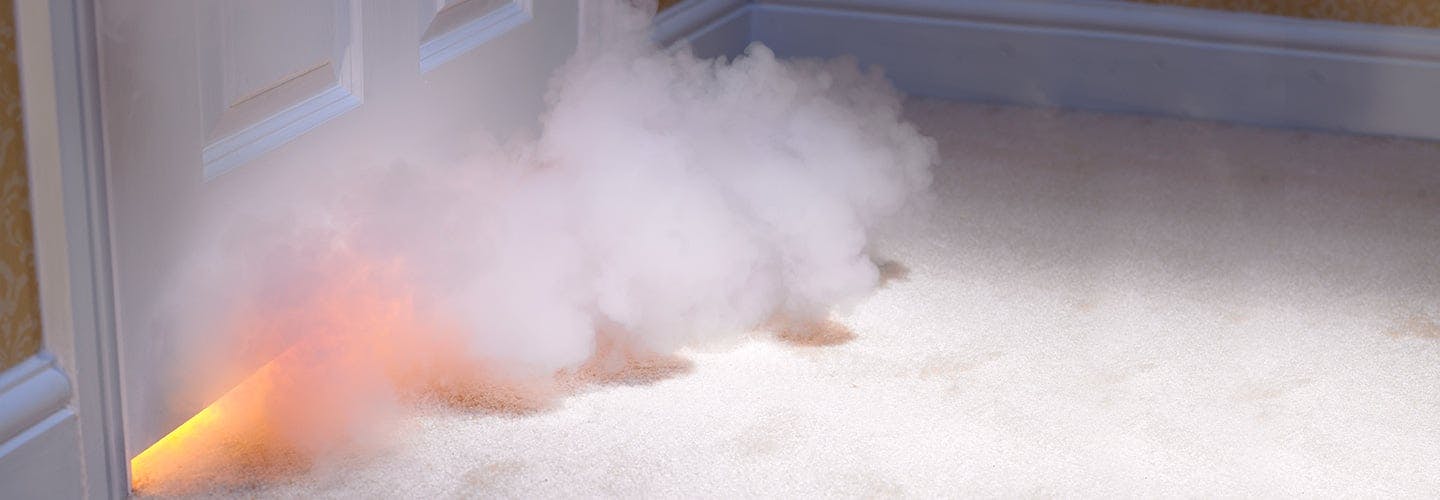Fire safety at home
- Crisis management
- Planning ahead
- Homeowners insurance

Fire and lightning accounted for 23.8% of homeowners insurance losses in 2020. It was second only to wind and hail. Fortunately, there are a lot of things that you can do to improve your fire safety at home and lower your risk.
Home fire safety tips for before the fire
Ways to minimize your risk of a house fire
- Never smoke in bed – or if you’re comfortable and sleepy in a chair either. Whenever you’re smoking, you should be alert and ready to take action if ash falls on something and ignites.
- Don’t leave candles unattended – it’s tempting to leave them burning while you run to the mailbox, but if they tip or something falls on them or a pet knocks them over, you won’t be around to stop the fire before it spreads.a pet knocks them over, you won’t be around to stop the fire before it spreads.
- Install smoke detectors – sometimes fires start when you’re in the other room. A smoke detector can often alert you to danger before your nose. This is especially true if a fire starts while you are asleep.
- Install a fire extinguisher – fires can’t always be prevented. Keeping a fire extinguisher on hand, and knowing how to use it, can mean the difference between a scary annoyance and a disaster.
- Use space heaters safely – place space heaters on a stable floor away from people, pets and fabric. The Electrical Safety Foundation International (ESFI) has a comprehensive list of space heater safety recommendations.
- Check electrical safety – do a visual inspection of your plugs, outlets, cables and connectors. If there is anything you’re unsure of, like an outlet that is hot to the touch, or if you want a more in-depth inspection, reach out to an electrician.
- Check natural gas safety – get a carbon monoxide detector to alert you to leaks and keep an eye out for unusual bubbling, damage or sounds from your gas lines. Call in the pros if you see anything that needs repair.
- Keep an eye on your cooking – kitchens are full of fire risks. Maximize your fire safety at home by staying put and watching what you’re preparing or checking often.
- Take an inventory – it's helpful to take an inventory of your household items, or even better, take a video in each room of the house. This will document all your valuables for easier settlement.
Helpful fire safety products
- Smoke detector – be alerted to fires faster with a smoke detector.
- Carbon monoxide detector – while these don’t detect or predict fires, carbon monoxide can come from things that are fire risks such as generators running inside.
- Fire extinguisher – put out small fires as soon as they start with a home fire extinguisher.
- Fire blanket – these can be used to put out fires in the home. They’re placed over the fire to smother it.
- Fire escape ladder – homes with two or more stories should have a fire escape ladder in every room on the upper floors to get people out safely.
Most common housefire causes
The National Fire Protection Association (NFPA) says there are five top fire causes:
- Cooking – responsible for 49% of reported home fires.
- Heating – leads to 500 deaths and 1,350 injuries annually.
- Electrical – involved in an average of 32,620 house fires each year.
- Smoking – causes the most deaths annually at 23% of home fire deaths.
- Candles – produce an average of 20 reported fires daily.
Rest easy with the right homeowners insurance
Home fire safety tips for during the fire
Use your fire escape plan
The NFPA recommends making a fire escape plan with all members of your household for what to do in case of a fire. You should walk through each room and look for possible exits. While doing your walkthrough, try to open the windows and doors to be sure that your exits are usable in case of emergency. Be sure that everyone is able to get out. Make a plan for family members with mobility limitations or children to be sure that they’re able to get out or that someone is assigned to help them.
During a home fire, put your plan into practice. Use the nearest exit you’ve previously identified and meet your family at a decided upon place a safe distance from the house. Once you’re at your safe spot, do not go back inside for any reason. Firefighters can take it from here.
Use your fire extinguisher or fire blanket
Learn how these items work ahead of time so you will be ready and able to use them in an emergency.
Fire extinguisher
When fighting a fire, you need to use the correct fire extinguisher for the type of fire you have. There are five types of fire extinguishers, explained by the Federal Emergency Management Agency (FEMA)
- A – ordinary materials like cloth, wood and paper
- B – combustible and flammable liquids like grease, gasoline, oil and oil-based paints
- C – electrical equipment like appliances, tool or other equipment that is plugged in
- D – flammable metals (common in factories)
- K – vegetable oils, animal oils and fats in cooking appliances (common in commercial kitchens)
When buying a fire extinguisher, it’s wise to look for one that is labeled for use on fire types A, B and C for your fire safety at home. Most home improvement stores will sell multipurpose fire extinguishers, so you only need one and won’t need to locate the correct one in an emergency.
When using your fire extinguisher, FEMA and the US Fire Administration say to remember the acronym PASS:
- Pull the pin.
- Aim low at the base of the fire.
- Squeeze the lever slowly.
- Sweep the nozzle from side to side.
Fire blanket
These are less common in the United States but are still a useful tool. They’re simple to use and can be a good alternative for someone who is inexperienced or uncomfortable with fire extinguishers. These should be used with small fires. If the fire is larger than the blanket, do not use a fire blanket. To use a fire blanket:
- Turn off the heat/fire source – do this only if it is safe. This step can be done later if it is not safe to do first.
- Pull the tabs to remove the blanket – these are stored in boxes or bags and need to be released to be used.
- Protect your hands – put on fire resistant gloves if they’re easily accessible. If they’re not, wrap the blanket around your hands for protection.
- Hold the blanket in front of you – think of using it as a shield.
- Put the blanket on the fire – cover the fire to smother the blaze and extinguish the fire.
- Leave it alone – don’t touch it until it is completely cooled with no chance of the fire starting again.
Home fire safety tips for after the fire
The first things to do after a house fire
- Find a place to stay – even a small amount of damage will make your house unlivable, at least temporarily. Talk to family and friends and find a safe place for yourself while you make plans to get back into your own home.
- Call your insurance company – they will want to start a claim quickly and can tell you what documents you’ll need to get it done quickly and completely. The VIU by HUB Advisory Team is also here for you to answer any questions you might have.
- Gather your documents – you’ll need the fire report from the fire station, but there may be other documentation that your insurance company asks for. Your insurance company will let you know what documents they’ll need.
- Protect the house – safeguard it from weather and break-ins as much as you can until it’s repaired and you’re living in it again.
- Check your pets – any pets that were in the fire will need a check up with their vet for trauma, burns and lung damage.
- Check your people – people are more able to speak up when they are injured by a fire than pets are, but it’s still a good idea for a check up of both physical and mental health in the days following a fire.


